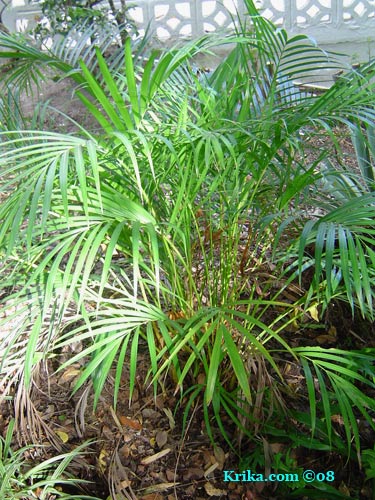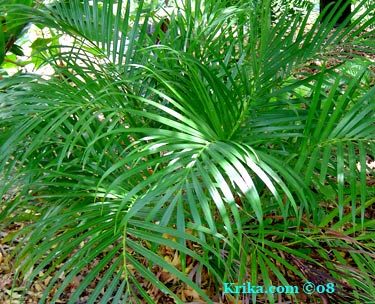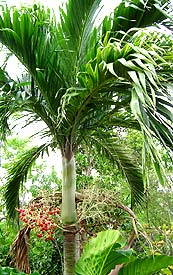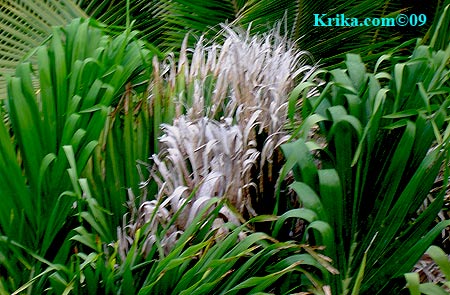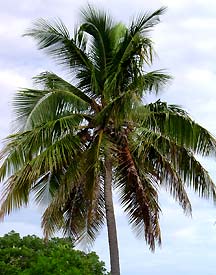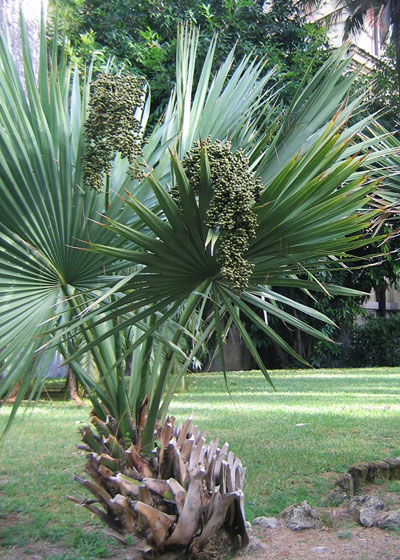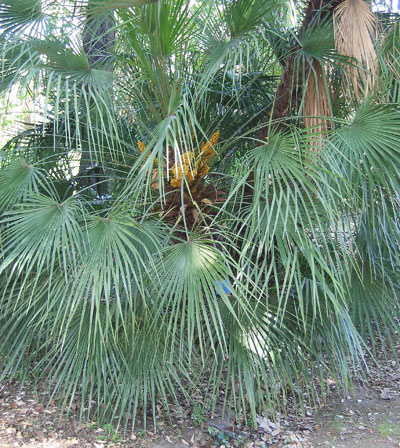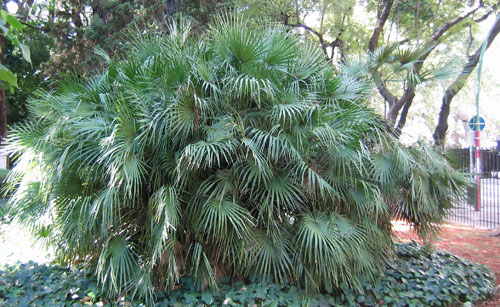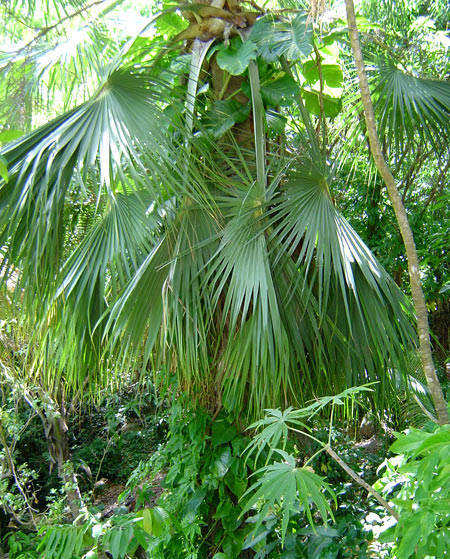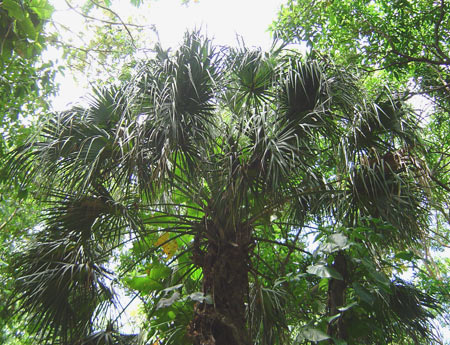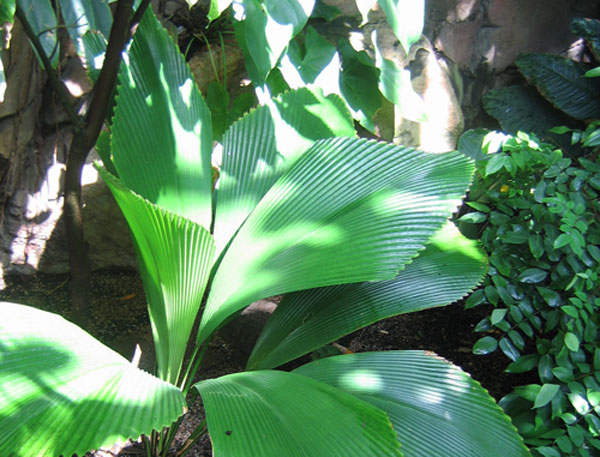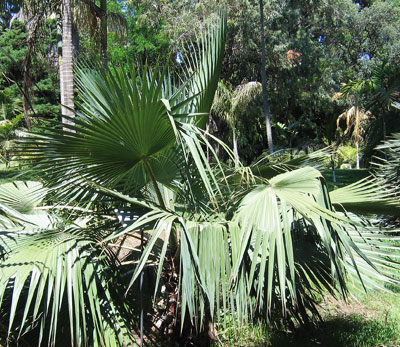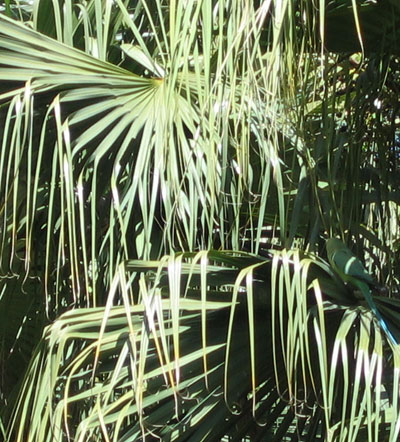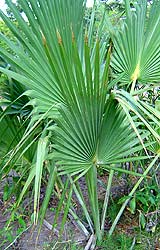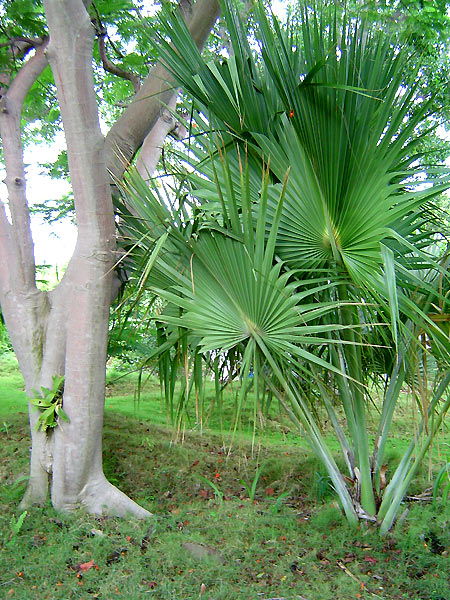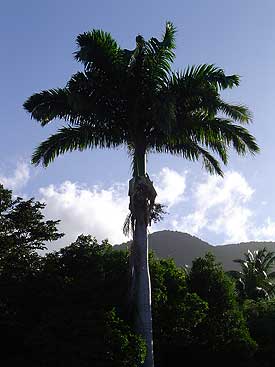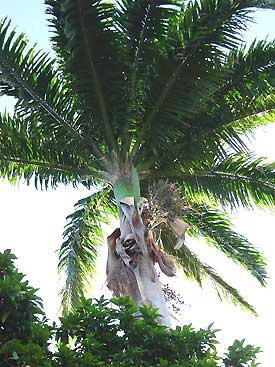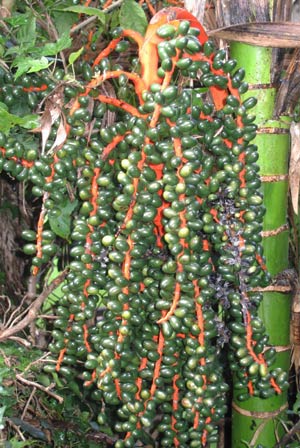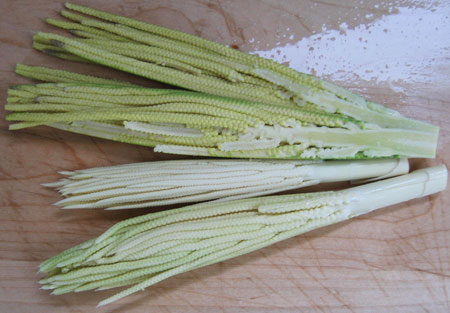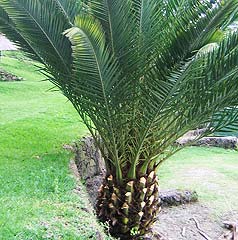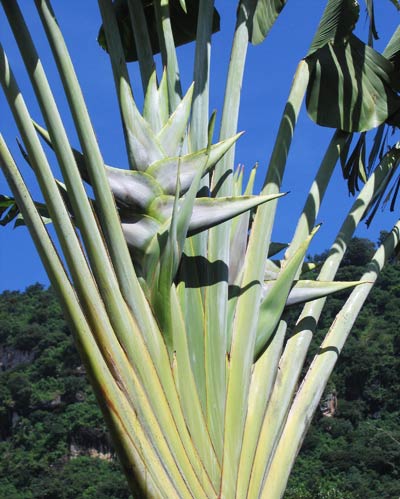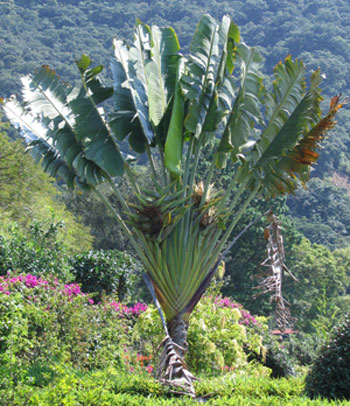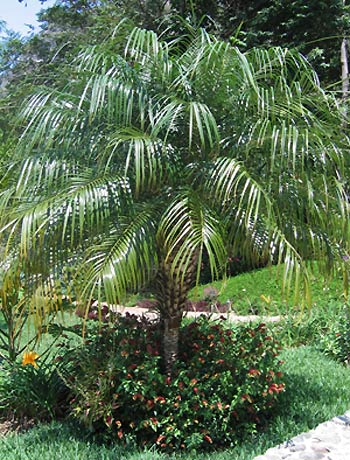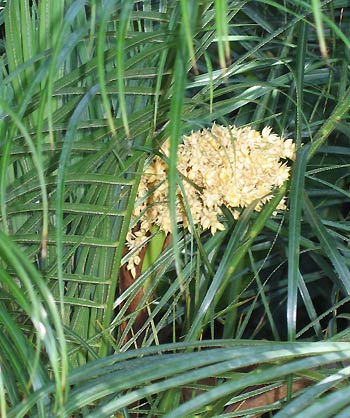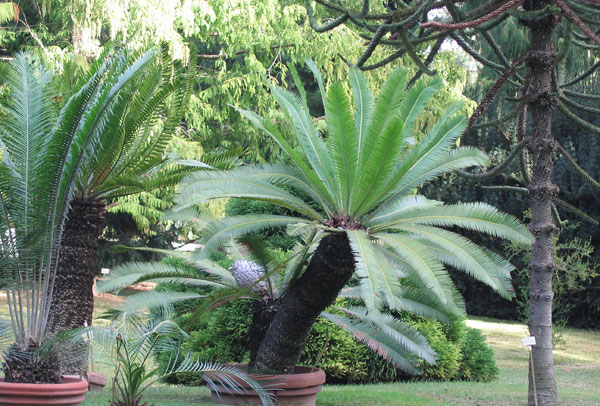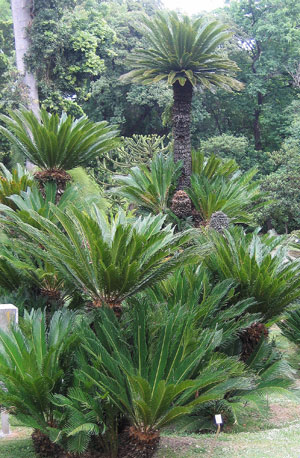| |
**Bamboo
Palm Tree, Areca Chrysalidocarpus lutescens or Chamaedorea
seifrizii or Chamaedorea erumpens
This is a lovely clumping type of palm whose one and a half to two inch thick
stems look much like bamboo. It grows to be between fifteen and thirty feet tall
and is just about as wide as it is tall when fully grown. You can also plant
the stems individually, but they seem less interesting and lonely planted that
way.
Benefits: This is one of those special plants that clean the
air for you and expect very little in return. If you are moving into a new home
or apartment
or if you have recently purchased new furniture or rugs the bamboo palm is perfect
for you -- it removes formaldehyde from the air. Off gassing of the products
used in furniture and home construction are loaded with formaldehyde which is
not
at all good for you to say the least.
Great at removing formaldehyde from the air, the bamboo palm is also low-maintenance:
Just put it where it will get a couple of hours of direct sunlight, and water
it regularly.
From: Central America
Photographed: In the garden at our former home in Montserrat
2008 and
in
the
Jardin Botanique in Tahiti in 2013.
Planting
and
Care: We
have
seen
them
growing in full sun and light shade. In Montserrat, our small one was growing
pretty
much
in
full
shade
and
was beautiful. They are said to like a moist soil, but we did not find that one
to
be particularly
picky; it survived a long drought while we were away one year with no apparent
damage. As
they mature, they are said to become more hardy. We now have a couple of dozen
large clumps of well established bamboo palms surrounding our property in Guatemala.
They are hardy and wonderful.
Text and Photographs Copyrighted ©Krika.com
2008 and ©GreenGardeningCookingCuring.com 2013 |
|
If
you have the space, bamboo palms make lovely hedges providing
shade while making a strong tropical landscape statement. The photograph
below was taken looking into the garden from the parking lot
at the Jardin Botanic in Tahiti in 2013. |
|
| |
**Cabbage
Palm Tree, Christmas Palm Roystonea oleracea or Veitchia
merrilli or Adonidia merrilli
This
tree is the tallest member of the palm family. It has frothy
leaves and red berry clusters. The cabbage palm grows pretty
slowly relative to everything else in the garden. Even at
its happiest with the right soil, water and sun it is SLOW.
Maybe the reason is the amount of tree trash it produces
as surely that takes up a lot of energy. We
have continual leaf dropping, elaborate flower bearing stems
and the seed bearing red berries you can see in the photo
to the left. Each berry surrounds one seed and thousands
are produced each year. The tree makes a great effort to
do this, despite the fact that each of the
seeds in the berries seems viable and ready to grow with
no encouragement. This is a beautiful tree that expends great
effort to insure its future generations.
Photographed: At our former home in Montserrat.
Planting
and Care: Our experience with these trees is that they
prefer full sun, a rich soil and routine rainfall or watering to
be at their best. If they find themselves growing in less advantageous
situations, they grow more slowly and look sort of peaked. The
photograph to the right shows what can happen to these palms in
a strong tropical storm with high winds. Aptly, the damage done
is called wind burn and there is nothing you can do about it but
wait for the damaged leaves to be gradually replaced.
Gardening Suggestion: If you have one or more
of these lovely trees, think about cutting off the flower stems
before they fruit and drop seeds. It will save you hours of clean
up or weeding later.
Text
and Photographs Copyrighted ©Krika.com 2008 |
|
| |
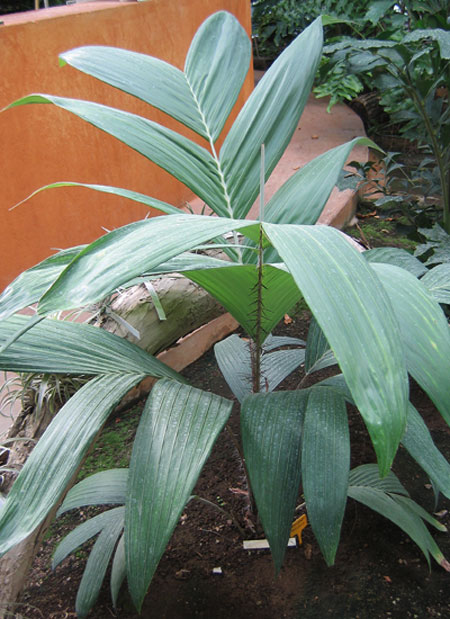
|
Chocho
Palm Astrocaryum mexicanum
From: Mexico
Photographed: In the (Ortobotanico)
Botanical Garden in Naples, Italy, in 2014.
Planting and Care:
Text
and Photograph Copyrighted ©GreenGardeningCookingCuring.com
2015
|
|
| |
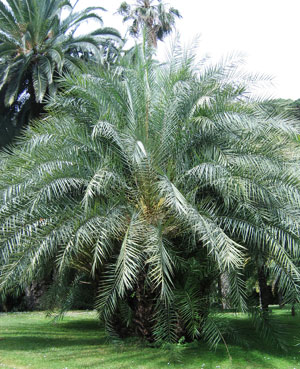
|
Cliff
Date Palm Phoenix rupicola
From: Cliff sides and mountainous terrain in
forested areas of India and Bhutan
Photographed: In the Botanical Garden in Naples,
Italy.
Text & Photograph
Copyrighted © KO 2008 |
|
**Coconut
Palm Tree Cocos nucifera
Our old
favorite. New trees will usually begin bearing in three to
five years and will eventually reach from forty to sixty feet
tall. We had one great old tree which always seemed to be covered
in unreachable nuts.
Benefits: When
opened and sun dried, coconuts form a material called copra
which is the source of coconut oil used in cooking and in making
soap (see the recipe below for making coconut oil). From
Yahoo News we get even more information on the glories of coconut,
"It's the fruit that has supplied water, food and oil
to societies around the world through generations. And, it
has also been
found to provide relief to multiple illnesses like hepatitis,
osteoporosis and diabetes."
Diseases: The truly disastrous disease called lethal yellowing has killed
coconut palms all the way from Miami to Mexico and the Caribbean. There are some
reasonably effective though laborious treatments, but there is no real cure.
The only alternative is to plant dwarf varieties which are immune, but no where
near as attractive or as productive of coconuts. Malpan is said to be one very
disease
resistant
variety.
Fruit: Immature
coconuts are the source of coconut water.
Planting
and Care: Give a fertilizer to the coconut palm only in
the spring.
|
|
|
Recipe: Coconut
Oil
Coconut oil
has a creamy coconut flavor and is best used on medium heat
as it will burn on high heat.
1. Husk old coconuts that have no liquid inside (give the coconut a shake to
hear whether there is liquid inside). Grate them or put them through a
food
grinder
and let the coconut soak in water to cover for about a day.
2. Drain the grated coconut, saving the water. Squeeze the grated coconut as
hard as you can saving the milk to mix with the saved water. Let it sit a while
and then gently put this mixed liquid in the refrigerator overnight. In the cool
air the coconut oil will rise to the top of the water forming a "cake."
3. Remove the cake and heat it on the stove to a gentle boil to remove all of
the water that may remain. As this process goes on the oil will become very clear.
Being careful to keep the oil at a simmer (coconut oil has a low boiling point)
be sure that all of the water is gone and then cook it a little more. Water left
in the oil will very much reduce its useful life.
Text & Photograph Copyrighted © KO 2008 |
| |
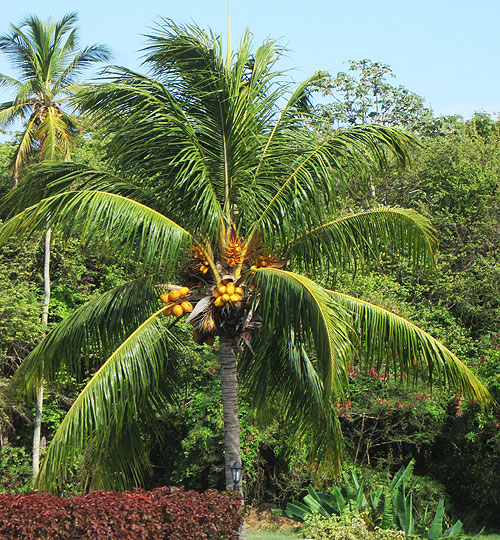 **Dwarf
Coconut Palm Tree **Dwarf
Coconut Palm Tree
Given to us in 2003 by our friend Roots in Montserrat, it was gone from our garden
when we returned from a long holiday.
Diseases: The dwarf coconut is resistant to the lethal yellowing
disease that has caused the destruction of so many coconut plantations in the
Caribbean, Mexico and elsewhere. Though it is no where near as majestic as the
real thing, the dwarf coconut might have proven a viable option if we only hadn't
taken a vacation.
Yield: You can expect the dwarf coconut to bear fruit four years
after it is planted.
Text Copyrighted © KO 2008 |
| |
Date
Palm Phoenix dactylifera
This is one of those wonderful plants that mirrors the
best of our humanity. To bear fruit, the date palm requires
a male
and female tree in relatively close proximity. On the Greek
island of Naxos we stopped in a small coastal town for a night.
Behind
our lovely hotel were several fruit laden lemon trees and many
artichoke plants. In the front of our room was a lovely windowed
balcony overlooking the sea beside two beautiful date palms.
We spoke with the older owners and with their son who happened
to be visiting that weekend and learned of the male and female
relationship of the date palm. I found it charming.
Benefits: Who is it that doesn't love dates?
From: The Middle East probably near Iran.
Planting and Care:
Text and Photograph Copyrighted ©GreenGardeningCookingCuring.com
2014
If
you would like to read my story of our visit to Naxos, here
is the link to it,
http://www.krika.com/STORIES%20GREECE/NAXOS.html |
Photographed: In
public gardens in Malaga, Spain, in 2014.
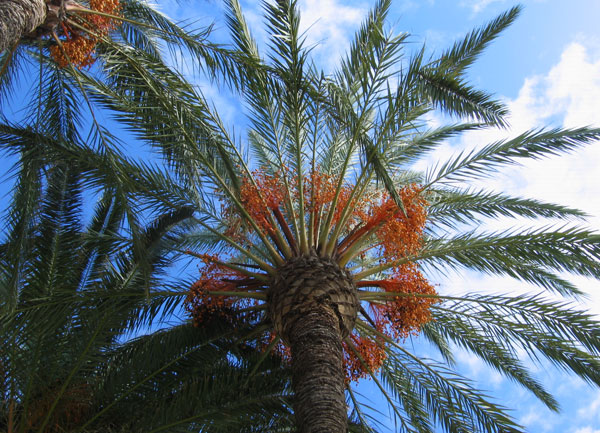
|
|
Photographed: In
the Jardim de Olhao, in Agadin, Morocco, in 2014.
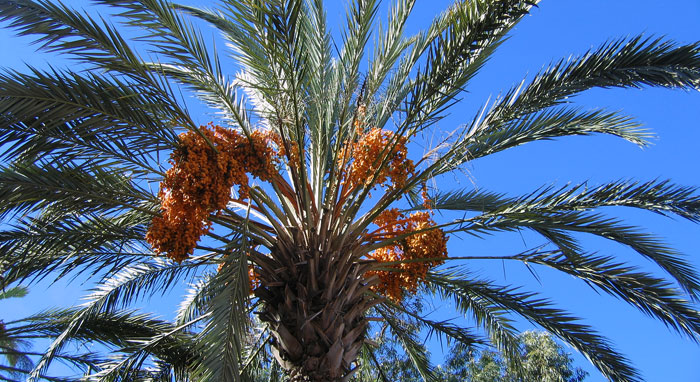
|
Photographed: In
public gardens in Malaga, Spain, in 2014.
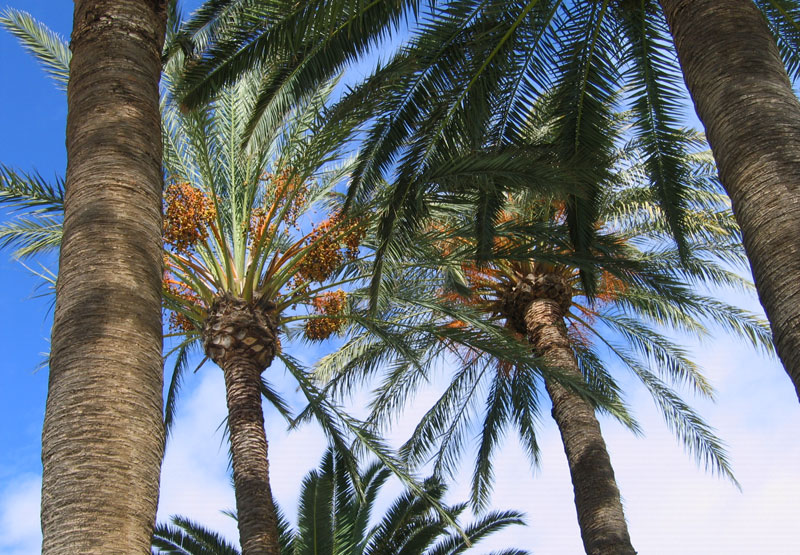
|
| |
|
FAN
PALMS
This
is an ever expanding group of palms that I am currently at a
complete loss to identify apart from including them in the group.
Except for enjoying the photographs of these wonderful trees,
you may think of this category of palms as "under
construction" and
get back to it later. If you have any help to offer I would be
very grateful to hear from you. |
| |
Bismarck
Palm Bismarkia nobilis
These stunning gray green palms will grow to be 60 feet tall eventually, but
I think you'll have a long time to wait. Buy one as large as you can, plant it
and enjoy.
Benefits:
From: Madagascar
Planting and Care: This is not one of the winter tolerant palms
and it needs a lot of space. On the plus side it is drought tolerant and given
more heat it will grow faster making it perfect for relatively dry tropical gardens.
Text and Photograph Copyrighted ©GreenGardeningCookingCuring.com
2012 |
Photographed: At
the Hotel Atitlan on Lake Atitlan in Guatemala.
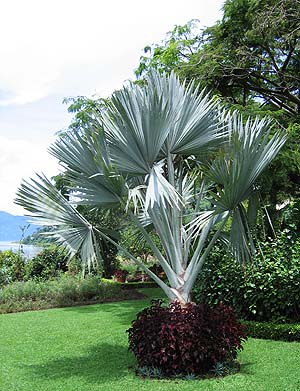
|
Photographed: At
the Hotel Atitlan on Lake Atitlan in Guatemala.
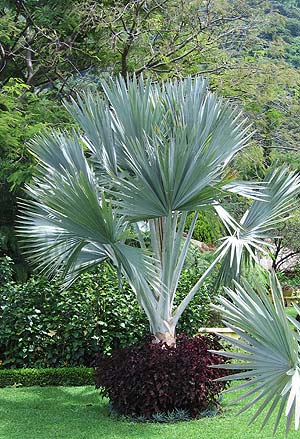
|
|
| |
Photographed: In
the Palermo
Botanical Garden in Sicily, Italy, in 2012
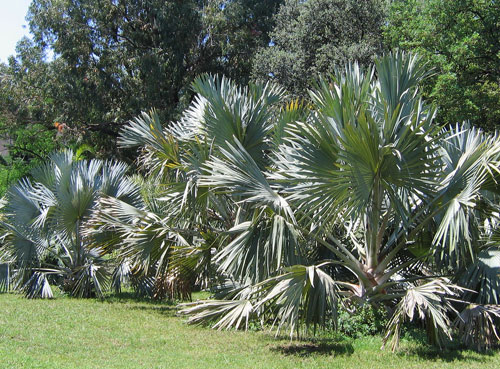
|
Photographed: At
the Hotel Riviera also on Lake Atitlan.
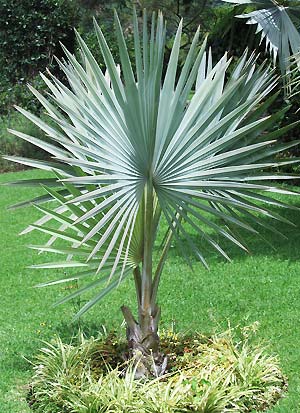
|
|
| |
Caranday
Palm Trithrinax campestris
Carandays grow under difficult circumstances, but can reach a height of just
under 20 feet. As they grow they maintain their old foliage to give them some
protection.
Benefits:
From: Uruguay and northern Argentina
Photographed: In the Botanical Garden in Palermo, Sicily, in
Italy in 2012.
Planting
and Care: The caranday palm likes a tough life preferring an arid climate
and
rocky soil.
Text
and Photograph Copyrighted ©GreenGardeningCookingCuring.com 2014 |
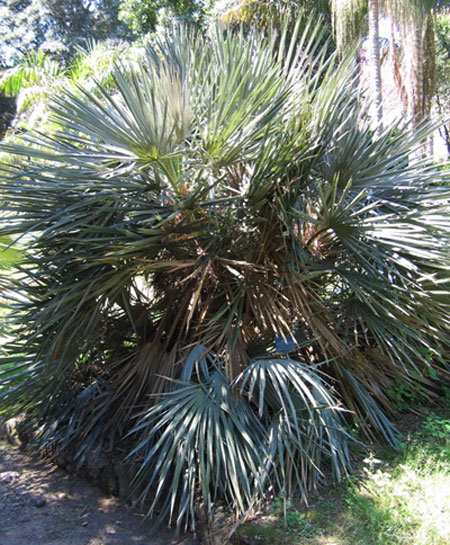 |
|
| |
|
Dwarf
Palmetto Sabal minor
Benefits:
From:
Photographed: In the Botanical Garden in Naples, Italy, in 2014.
Planting and Care:
Text and Photograph Copyrighted ©GreenGardeningCookingCuring.com
2015 |
|
| |
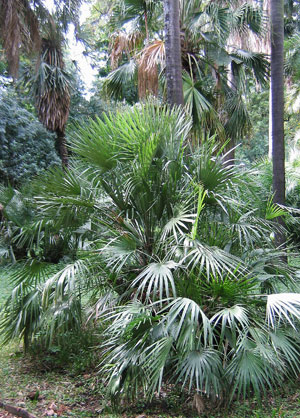
|
European
Fan Palm Chamaerops humilis
This is a slow growing rather small variety of palm; it grows to be only
about 10 feet tall.
From: Areas around the Mediterranean
Photographed: On the left in the Carlos Thays Botanical
Garden in Buenos Aires Argentina, below on the left in the Palermo Botanical
Garden in Sicily, Italy, and on the right also in Buenos Aires.
Planting and Care: This palm is relatively
cold hardy, being able to handle frosts with no problem.
In fact it doesn't grow well in hot climates. It prefers
full sun and is pretty indifferent to soil quality.
Text
and Photograph Copyrighted ©GreenGardeningCookingCuring.com
2012
|
|
| |
|
| |
**Fan
Palm, Lankan Palm Lantana
litigious or Copernica baileyana
This is a spreading palm with fan-shaped fronds.
Text & Photographs Copyrighted © KO
200 |
|
| |
Joey
Palm, Diamond Joey Johannesteijsmannia altifrons
This is a very striking plant which grows without a trunk, leaves emerging
one after the other at ground level.
Benefits:
From: Thailand, Borneo, Sumatra, Indonesia and Malaysia
Photographed: In
the Royal Botanic Garden in Sydney, Australia, in 2013.
Planting and Care: As you can see from the area
of the world that the Joey Palm first lived, it is tropical in
nature though it can survive in the warmest humid areas of the
US.
Text and Photograph Copyrighted ©GreenGardeningCookingCuring.com
2014
|
|
|
| |
Lady
Palm Rhapis excelsa
Benefits: According to an article on Yahoo news, this palm
is an air cleaning plant that will free "...your air of chemicals, including
ammonia, and [it is] is highly resistant to insects."
From: Southern China and there about's
Photographed: In the Royal Botanical Gardens in Sydney,
Australia, 2013.
Planting and Care: It is said to be fairly easy to care for
preferring low light and being happy in a low humidity environment.
Text Copyrighted ©GreenGardeningCookingCuring.com
2013 |
| |
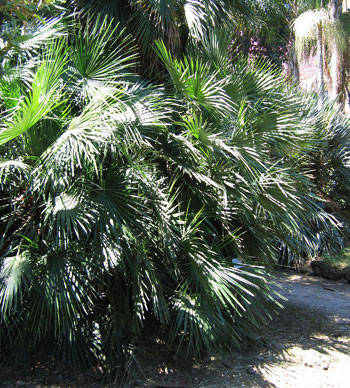
|
Mediterranean
Fan Palm Chamaerops humilis
This modest and appealing palm is full and lovely while keeping itself to about
20 feet in height.
Benefits:
From: Southern Europe and Northern Africa
Photographed: In the Palermo Botanical Garden in Sicily, Italy.
Planting and Care: This is another excellent choice for
a xeriscape garden as the Mediterranean Fan Palm is drought tolerant. Happily
it is also tolerant of cold and it is accepting of a wide variety of soils. It
does, however, want to grow in full sun.
Text and Photograph Copyrighted ©GreenGardeningCookingCuring.com
2012 |
|
| |
Rock
Palm Brahea dulcis
This beauty is one of what I call the "lazy frond" palms. They are
not stiff, but laze about a little just like I like to do. They are quite lovely
to see
in the garden by your chaise lounge.
Benefits:
From: Mexico
Photographed: In the Palermo Botanical Garden in Sicily, Italy.
Planting and Care: This is a very slow growing palm so if you
wish, buy the size you want or close to it as it will be that size and a little
bit for a very long time. In the end it will be about 12 feet tall and 8 feet
wide. The rock palm prefers low humidity and as you would assume, it is drought
tolerant. It also has some tolerance to frost, but not to freezing temperatures.
It likes to have a regular dose of a moderate amount of water and to live in
full sun.
Text and Photograph Copyrighted ©GreenGardeningCookingCuring.com
2012 |
|
| |
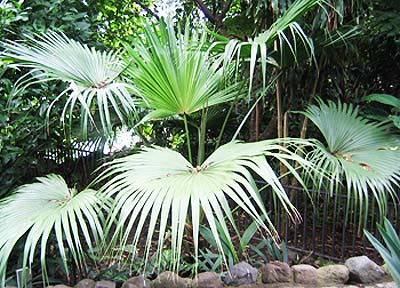
|
Fan
Palm Mystery #1
Photographed: In the Botanical Garden at the Hotel Atitlan on Lake Atitlan
in Guatemala.
Text and Photograph Copyrighted ©KO
2010
Hint: Do you think this could be a
Miraguama Palm Coccothrinax miraguama
From: Cuba?? |
|
|
Fan
Palm Mystery #2
Nicknamed: "Very Hairy Palm"
Photographed: At the entrance to the Hotel Riviera on Lake Atitlan in
Guatemala.
Text
and Photograph Copyrighted © KO 2010
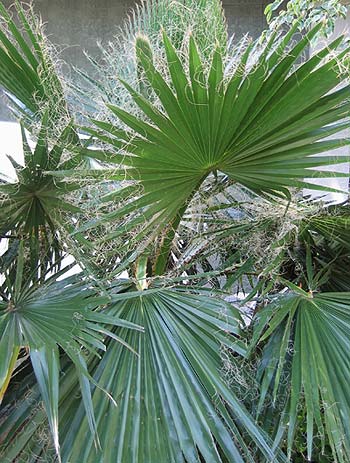
|
Fan
Palm Mystery #3
Photographed: On
the grounds of the Hotel Riviera on Lake Atitlan in Guatemala.
Text
and Photograph Copyrighted © KO 2010
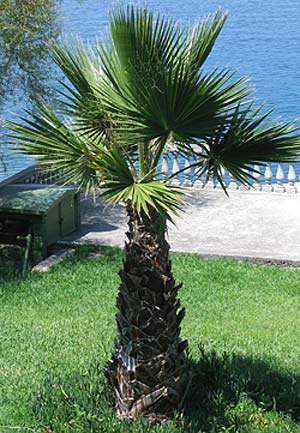
|
|
| |
Fan
Palm Mystery #4
This
beautiful palm lived under our orange flowering flamboyant
tree. It is hard to know which of the palms it actually is
from the photographs we've seen in garden books so if you
can identify it, please drop us a line.
Photographed: These are two photographs of our lovely fan palm, one
taken in 2003 and one five years later in our garden at our former home in Montserrat.
Text
and Photographs Copyrighted © Krika.com 2003/2008 |
|
| |
Fan
Palm Mystery #7
Hint: This may be a Livistona chinensis from China.
Photographed: In the Botanical Garden in Buenos Aires, Argentina,
in 2011.
Text Copyrighted ©GreenGardeningCookingCuring 2011
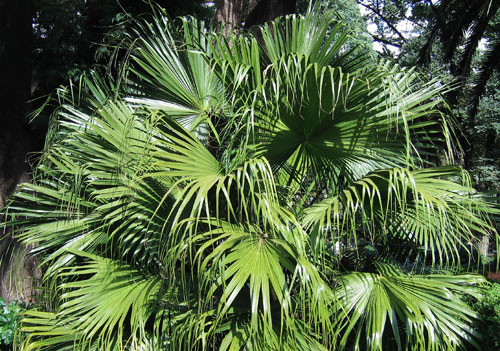
|
Fan
Palm Mystery #8
Benefits:
From:
Photographed: In the Carlos Thays Botanical Garden in Buenos
Aires, Argentina.
Planting and Care:
Photograph Copyrighted ©GreenGardeningCookingCuring.com
2013
Note: This
palm looks very similar to my mystery #22 below, but the
leaves seem to be wider.
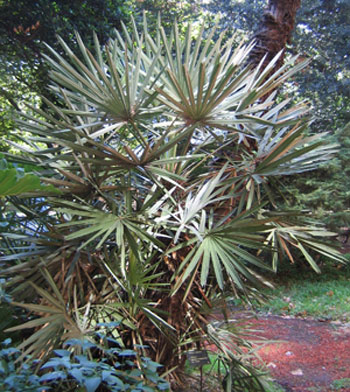
|
|
| |
Fan
Palm Mystery #22
As you can see in the photograph, this seems to be a smaller
yet still very attractive version of the very large Bismarck Palm.
Benefits:
From:
Photographed: In the Palermo Botanical Garden in Sicily, Italy.
Planting and Care:
Text and Photograph Copyrighted ©GreenGardeningCookingCuring.com
2012
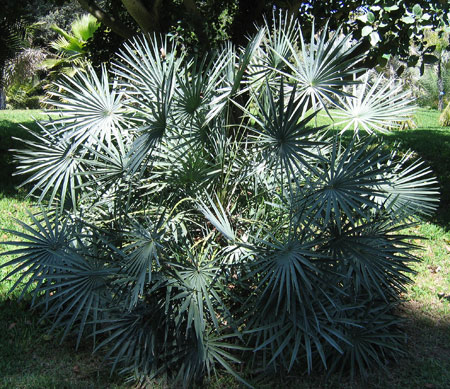
|
Fan
Palm Mystery #24
Benefits:
From:
Photographed: In the Palermo Botanical Garden in Sicily, Italy.
Planting and Care:
Text and Photograph Copyrighted ©GreenGardeningCookingCuring.com
2012
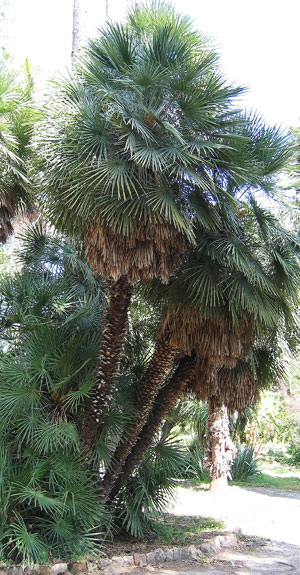
|
|
| |
Fan
Palm Mystery #25b
Photographed: In city gardens in Malaga,
Spain.
Text and Photograph Copyrighted ©GreenGardeningCookingCuring.com
2012
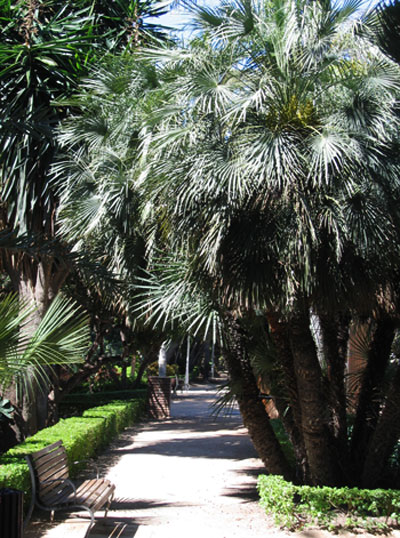
|
Fan
Palm Mystery #26
Photographed: In Jardim de Olhao, in
Agadiz, Morocco in 2014.
Text and Photograph Copyrighted ©GreenGardeningCookingCuring.com
2012
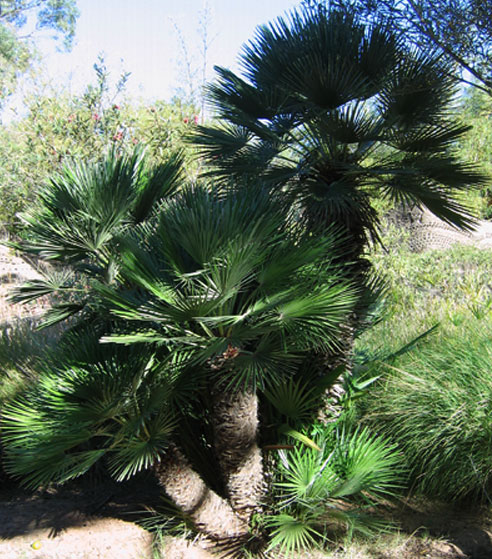
|
|
| |
Palm
Tree Mystery #27
Photographed: At the Magdelena Hotel
in Tobago in 2018.
Text and Photograph Copyrighted ©GreenGardeningCookingCuring.com
2018
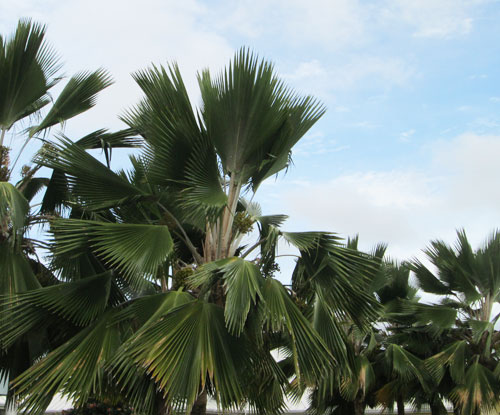
|
| |
|
| |
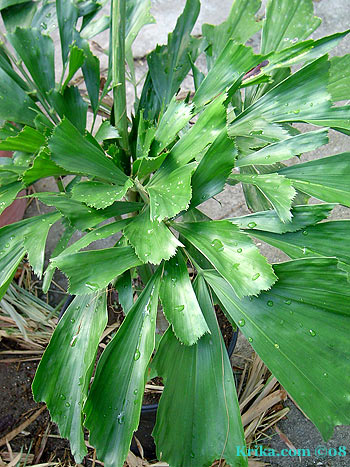
|
**Fish
Tail Palm Caryota mitis
Like the bamboo palm, the fishtail palm is a clumping variety growing only to
about twenty or thirty feet. It is very hardy as palms go and can even survive
a good bit of drought.
From: India
Photographed: In the garden at our former home in Montserrat
Planting and Growth: With overall tolerance to a range of
soils, light conditions (full sun to semi shady) and moisture levels, it sounds
almost too perfect and it is -- all parts of the fishtail contain an irritant
so keep your hands off! In our experience we have found that this palm likes
a good bit of water on a regular basis, although it will survive without it.
Text and Photograph Copyrighted © Krika.com
2008 |
|
| |
**Florida
Royal Palm, Cuban Royal Palm Roystonia elata
This is our most magnificent palm. It is about sixty
feet tall with more than a foot thick smooth cement colored
trunk. The debris from this tree is significant, so when
a frond falls we run! The heavy fronds are more than twelve
feet long. The characteristics that distinguish the cabbage
and royal palms are not particularly easy to observe, but
after seven years we finally did it. The berries on a cabbage
palm are red; on a royal palm they are a dark purple. Though
the trunks on these palms are similar in color, the royal
palm's is smoother. Regardless of which tree you have growing,
they are both wonderful. In truth, I'd have to say I rather
like the royal palm a bit better than the cabbage palm (even
its name sounds a little better, don't you think?).
Photographed: Just above the shady terrace garden at our former home
in
Montserrat
Planting and Care: Capable of reaching seventy feet when full
grown, this palm prefers fertile soil and lots of water to look its best along
with
an acid soil.
Text and Photographs Copyrighted © KO 2008 |
|
| |
Lipstick
Palm, Red Sealing Wax Palm Cyrtostachys Renda
or C. lakka
This is a striking plant and hence is coveted enough to have endangered it in
the wild. Just imagine paying $1000 US for just one plant.
Benefits:
From: Southern Malaysia, Borneo and Sumatra
Planting and Care: As you can imagine from its home place in
the world, this palm will like it humid, even wet, and hot. Give it some shade
or full sun and a soil that is not too rich in nutrients and it will do just
fine.
Text and Photograph Copyrighted ©GreenGardeningCookingCuring.com
2014 |
Photographed: In
the Jardin Botanique in Tahiti in 2013.
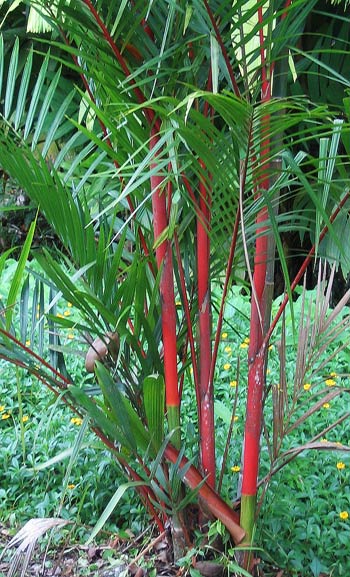
|
|
| |
Photographed: In
the Botanical Garden in Sydney, Australia, in 2013.
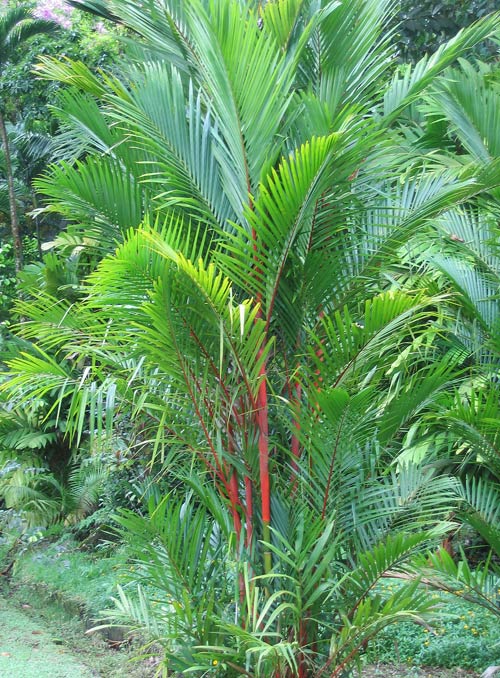
|
Photographed: In
the Botanical Garden in Sydney, Australia, in 2013.
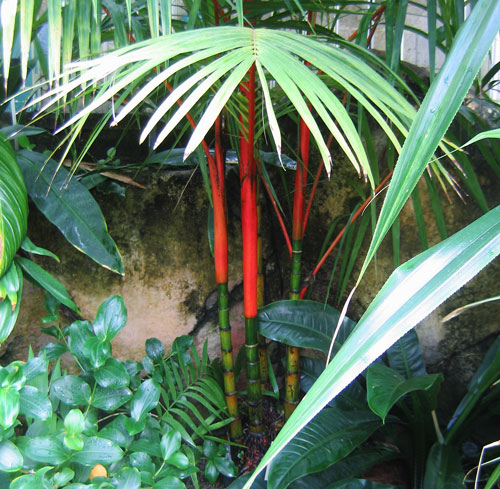
|
|
| |
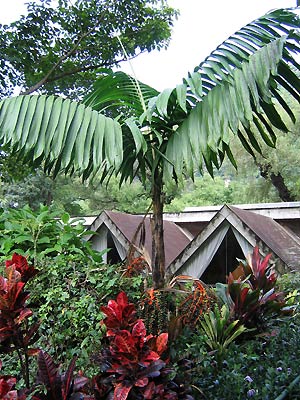
|
Pacaya
Palm Tree Chamaedorea tepejilote
This is a small palm, never reaching more than 20 or 30 feet in height. It is
delightful for its decorative seeds as seen in the photograph below on the left.
Benefits: The pacaya produces seed pods about 12 to 14" long
each filled with the soft seeds you see in the photograph below on the right.
The seed pods
are sold in the local market during the season. The seeds are cooked and used
as a vegetable, often in omelets. I find the taste similar to hearts of palm
one of my favorite tropical foods.
From: Central
and
Northern
South
America
Photographed: At the Hotel San Buenaventura on Lake
Atitlan in Guatemala.
Planting and Care: Pacayas like to live in the shade,
but will be tolerant of early morning or late afternoon sun. They like
a fair amount of moisture on a regular basis and a slightly acid soil
if they can get it.
Text and Photographs Copyrighted ©KO
2010 |
|
|
| |
Peach
Palm Bactis gasipaes
This is a palm used for palm hearts and for its extremely nutritious small fruits. |
| |
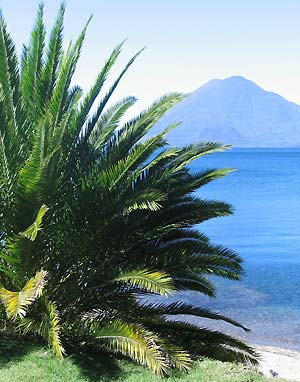 |
Pineapple
Palm
We were told this lovely palm floated down the stream beside the hotel
property
and took root on the lakeside beach. Some years later lake waters rose and then
rose some more until the fronds of this palm were floating. Once again it
went traveling.
Benefits:
Photographed: At
the
Hotel
San
Buenaventura
on
Lake
Atitlan
in
Guatemala.
Planting and Care:
Text and Photograph Copyrighted ©GreenGardeningCookingCuring.com
2010 & 2014 |
|
|
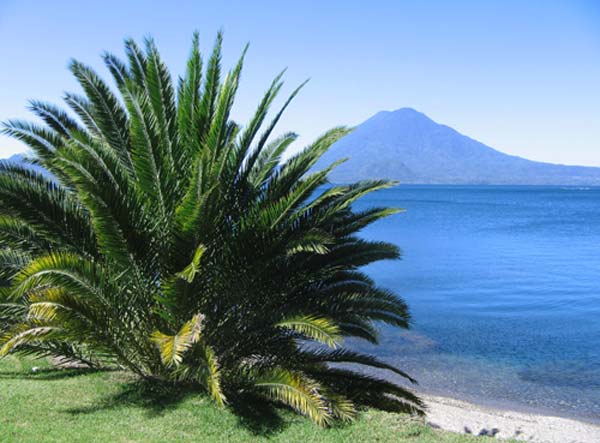
|
| |
Photographed: At
the Hotel Atitlan on Lake Atitlan in Guatemala in 2010.
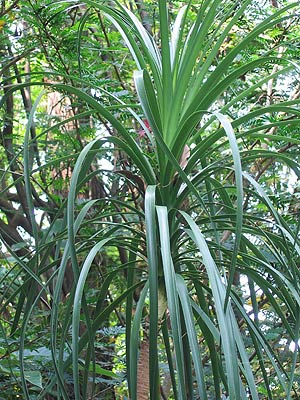
|
**Ponytail
Palm, Elephant's Foot Palm Nolina recurvata Hemsl.
Benefits:
From: Mexico
Planting and Care:
Text and Photograph Copyrighted ©GreenGardeningCookingCuring.com
2012
Identification
of my Mystery Plant #3 was helped along with the suggestion
of
a Twitter friend, Stanley B. from New York State. Many thanks.
|
Photographed: In
the Palermo Botanical Garden in Sicily, Italy.
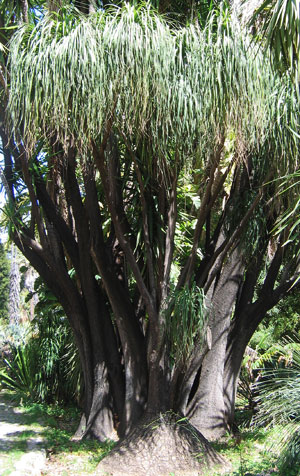
|
|
| |
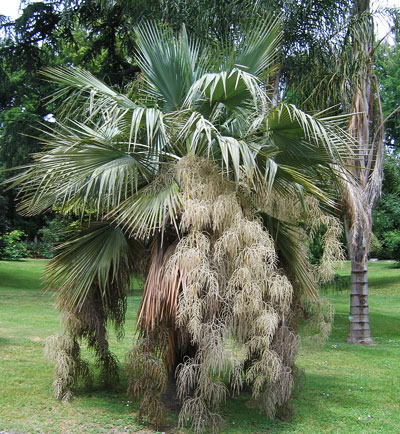
|
San
José Hesper Palm Brahea Brandegeei
This beautiful palm will eventually reach 45 feet in height.
From: Mexico
Photographed: In the Botanical Garden in Naples, Italy.
Planting and Care: This is a dry climate palm so it is relatively
easy to care for. Give it a place in full sun and some water and it will be off
and running. It is more cold tolerant than many other palms, but not below 25
degrees F.
Text
and Photographs Copyrighted ©GreenGardeningCookingCuring.com
2012 |
|
| |
Travelers
Palm Ravenala madagascariensis
Though not really a palm, the traveler is very appealing
and looks more like a relative of the banana.
From: Madagascar
Photographed: In the Botanical Garden
at the Hotel Atitlan on Lake Atitlan in Guatemala.
Planting and Care: I would say the most important consideration
with a travelers palm is can you provide a wind free place in the garden. When
the wind hits this stunning plant its leaves become shredded and very unattractive.
Plant it in any soil with good drainage in a sunny or bright semi shady spot
and it will delight you. Its only other requirement is routine rainfall or
watering.
Text and Photographs Copyrighted ©GreenGardeningCookingCuring.com
2012 |
|
| |
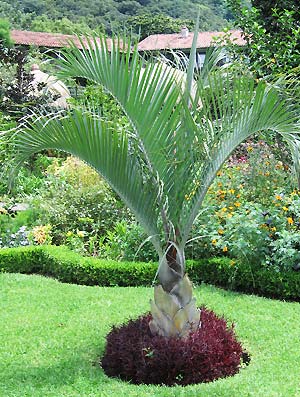
|
Triangle
Palm Dypsis decaryi (Jum.)
Growing to be about 45 feet tall, this peculiar palm has an almost perfectly
triangular trunk. Probably for that quality, its ease of care and its visual
appeal it has been exported to gardens around the world. It probably also has
lost its native territory to population growth and encroachment and is now considered
endangered.
Benefits:
From: Madagascar rainforests
Photographed: In the Botanical Garden at the Hotel Atitlan on
Lake Atitlan in Guatemala and finally identified in the Palermo Botanical Garden
in Sicily.
Planting and Care: Given the nature of its native place, plant
it in full sun and give it routine rainfall or watering. It can handle dry periods,
but does not particularly like too much water.
Text and Photograph Copyrighted ©KO
2012 & ©GreenGardeningCookingCuring.com 2014 |
|
| |
Palm
Tree Mystery #1
Photographed: In Buenos Aires, Argentina.
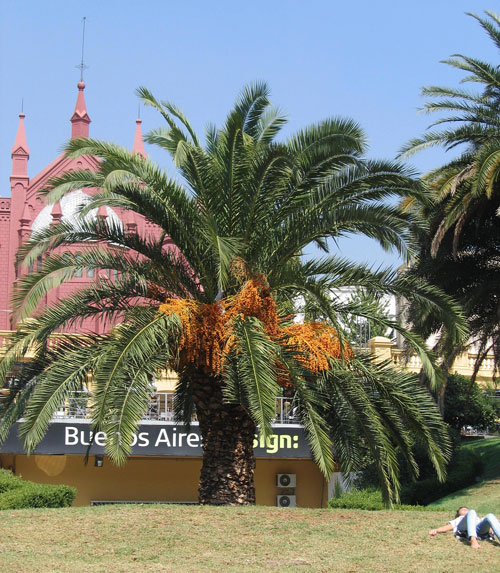
|
| |
Palm
Tree Mystery #4
This is a peculiar and attractive small palm that seems at
home growing here in the highlands of Guatemala. It has a trunk that
starts off small and gets larger as it grows up as you can see in the
photograph on the left.
Benefits:
Photographed: At the Hotel Riviera on Lake
Atitlan in Guatemala.
Planting and Care:
Text and Photograph Copyrighted ©KO
2010 |
|
| |
I think this
is similar to a Joey Palm, with the botanical name Licuala
orbicularis
Palm
Tree Mystery #5
Photographed: In the Jardin Botanique in
Tahiti, 2012
Photograph
Copyrighted ©GreenGardeningCookingCuring.com 2013
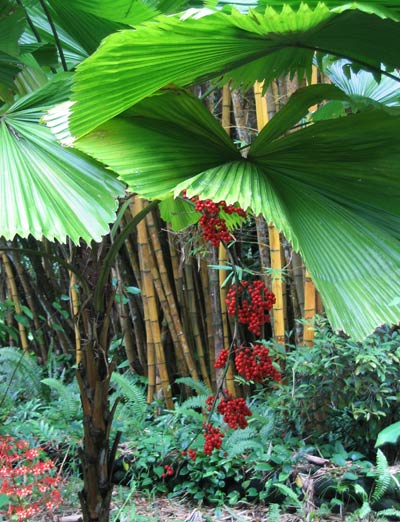
|
Palm
Tree Mystery #5a
Photographed: In the Jardin Botanique in
Tahiti, 2012
Photograph
Copyrighted ©GreenGardeningCookingCuring.com 2013
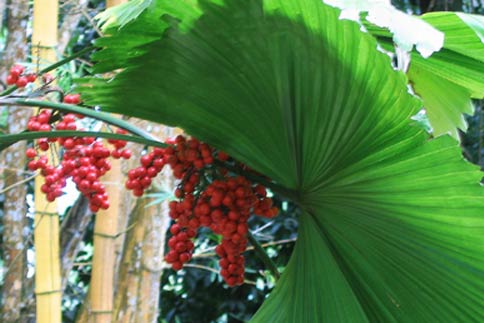
|
|
| |
Palm
Tree Mystery #6
Photographed: In the Jardin Botanique
in Tahiti, 2012
Photograph
Copyrighted ©GreenGardeningCookingCuring.com 2013
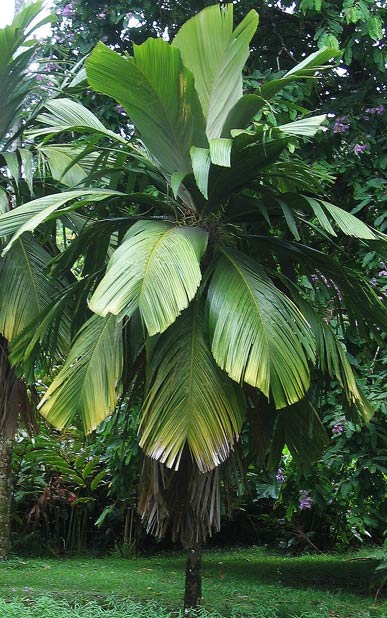
|
Palm
Tree Mystery #7
Photographed: In our garden at our former
home in Montserrat in 2008.
Photograph
Copyrighted ©GreenGardeningCookingCuring.com 2014
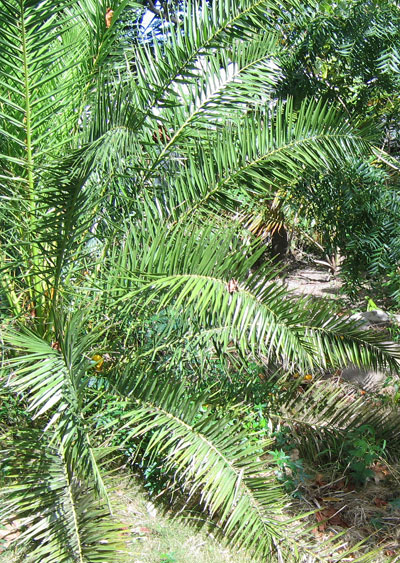
|
|
| |
Palm
Tree Mystery #8
Photographed: In the Botanical Garden in Naples,
Italy, in 2013.
Photograph
Copyrighted ©GreenGardeningCookingCuring.com 2013
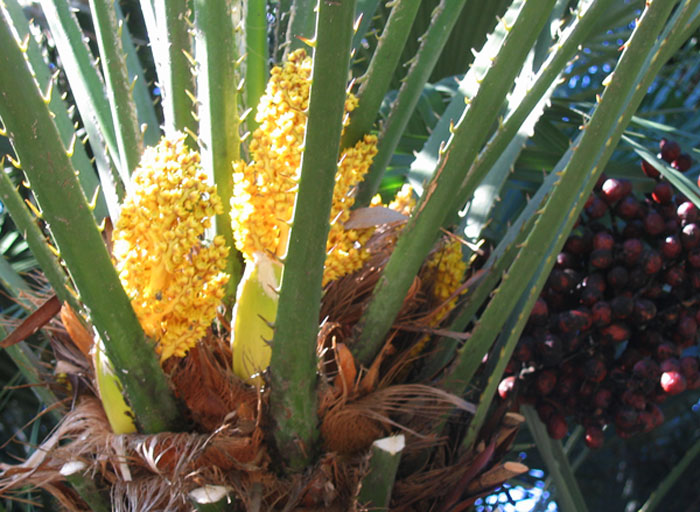
|
| |
Palm
Tree Mystery #27
Photographed: At the Magdalena Hotel
in Tobago in 2018
Photograph
©GreenGardeningCookingCuring.com 2018

|
| |
Palm
Tree Mystery #28
Photographed: At the Magdalena Hotel in Tobago
in 2018
Photograph ©GreenGardeningCookingCuring.com
2018
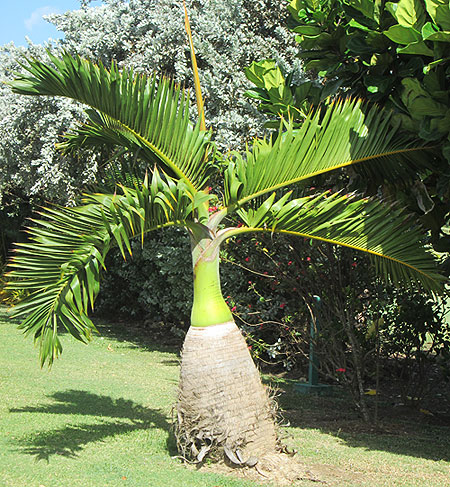 |
| |
| **Umbrella
Palm See the "U" Page
-- UMBRELLA PALM |
| |
Yatay
Palm
Benefits:
From:
Photographed: In the Carlos Thays Botanical Garden in Buenos
Aires, Argentina.
Planting and Care:
Text and Photograph Copyrighted ©GreenGardeningCookingCuring.com
2013 |
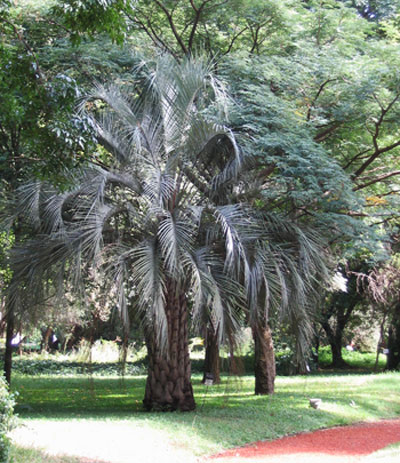 |
|
| |
| |
SAGOS & CYCADS |
|
Bread
Palm, Bread Tree, Kaffir Bread, Karoo Cycad Encephalartos
lehmannii (Zamiaceae)
This is a large family of very appealing cycads, ranging in colors from bright
green to blue gray green.
Benefits:
From: S. Africa
Planting and Care: This is both a frost and drought tolerant
cycad that grows in its native environment on sandstone slopes. Evidently it
also likes well drained soil.
Text and Photograph Copyrighted ©GreenGardeningCookingCuring.com
2012
An
interesting link,
http://www.cycadpalm.com/encephalartos.html |
Photographed: In
the city gardens in Malaga, Botanic Garden in Malaga, Spain,
2012.
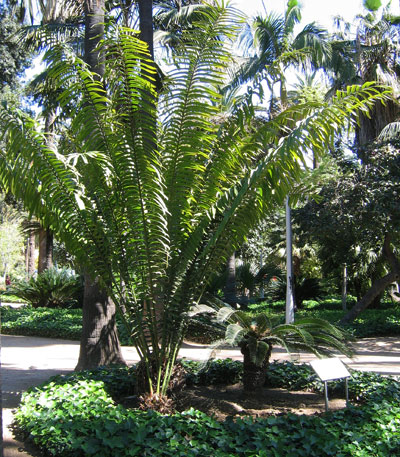
|
|
| |
Photographed: In
the Botanical Garden, Ortobotanico, in Naples, Italy,
2012.
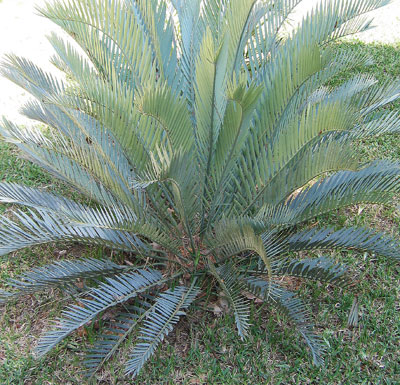
|
Photographed: In
the Botanical Garden, Ortobotanico, in Naples, Italy,
2012.
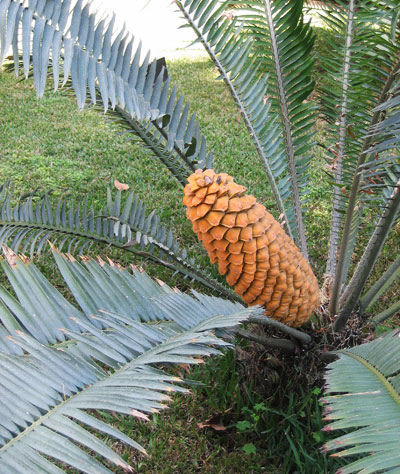
|
|
| |
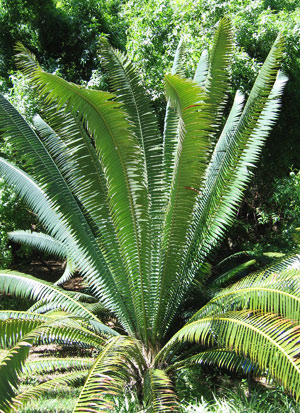
|
Giant
Dioon, Gum Palm Dioon spinulosum
In nature this beautiful plant will grow to be 50 feet tall. It has stiff fronds
and sharp edges.
Benefits:
From: Tropical Mexico
Photographed: In the Palermo Botanical Garden in Sicily, Italy.
Planting and Care: This plant thrives in rocky limestone forests
in tropical Mexico where it prefers partial shade and wet well drained soil.
Text and Photograph Copyrighted ©GreenGardeningCookingCuring.com
2012 |
|
| |
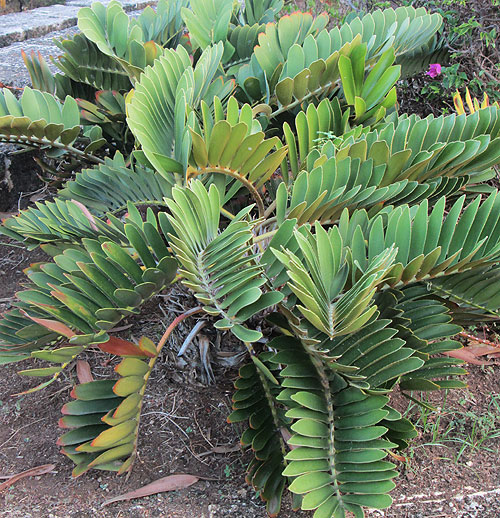 **Jamaica
Sago, Cardboard Palm, Scurfy Zamia, Cycad Zamia
furfuracea **Jamaica
Sago, Cardboard Palm, Scurfy Zamia, Cycad Zamia
furfuracea
This plant is aptly named for its stiff cardboard like leaves, but it could as
easily have a more charming name for its attractiveness. We first saw them growing
in the gardens of the hotel where we were staying in Antigua in the West Indies.
I came to a dead stop and fell in love. They are beautiful plants.
From: Mexico through northern South America
Planting and Care: This is a new plant in our garden and we'll
have to see how it goes. According to one source, the Jamaica sago prefers an
arid climate, but will do fine in one that is not if planted in a sunny area
with good drainage. The second source recommended planting this sago in semi-shade
and providing routine watering or rainfall to keep them happy. Update: So
far we have to agree with the folks who recommended a dry setting.
Text
and Photograph Copyrighted ©Krika.com 2008 and ©GreenGardeningCookingCuring.com
2014\ |
Photographed: In
the herb garden at our former home in Montserrat
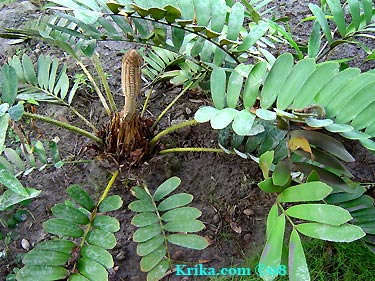 |
Photographed: In
Parque de la Leyendas, Lima, Peru, in 2013.
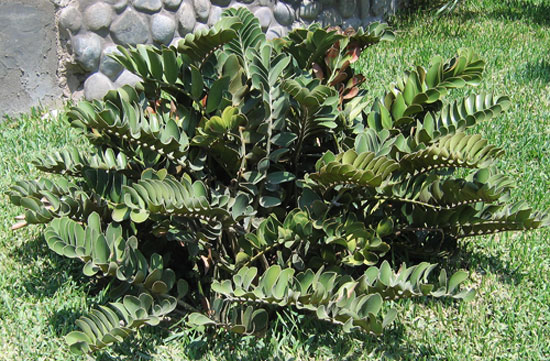
|
|
| |
Natal
Giant Cycad, Giant Tree Cycad Encephalartos natalensis
This is a long lived and slow growing cycad that will eventually reach a height
of 20 feet with 10 foot fronds. Plants are either male or female so you'll need
one of each if you plan to have more.
Benefits:
From: South Africa
Photographed: In the Palermo Botanical Garden in Sicily, Italy.
Planting and Care: Surprisingly frost and drought tolerant,
this cycad prefers to live in a bright semi shady area of the garden.
Text and Photograph Copyrighted ©GreenGardeningCookingCuring.com
2012 |
| |
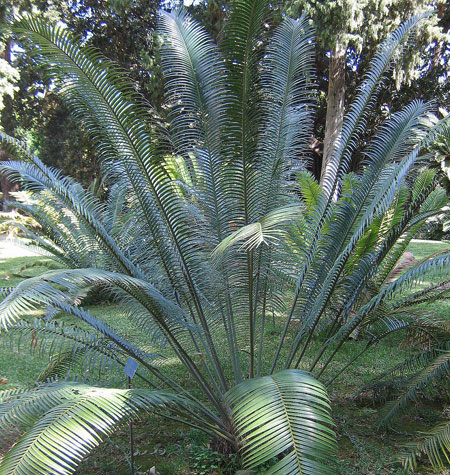
|
Pineapple
Zamia Lepidozamia peroffskyana Regel.
Benefits:
From: Eastern Australia
Photographed: In the Palermo Botanical Garden in Sicily, Italy.
Planting and Care: This slow growing cycad prefers light shade,
but will handle full sun as long as it gets very regular watering or rainfall.
It is not frost hardy.
Text and Photograph Copyrighted ©GreenGardeningCookingCuring.com
2012 |
|
| |
Sago
Palm Garden, Botanical Garden, Naples, Italy.
Photographs
Copyrighted ©GreenGardeningCookingCuring.com 2012 and 2014 |
| |
|
| |
**Sago
Palm, Gnu Palm, King Sago Palm Cycas
revoluta
This sago is a squat, beautiful, dark-leaved very primitive plant and one of
the oldest members of the cycad family. Sadly, in the winter of 2007 our sago
died
from the white scale infestation that was so destructive to these marvelous trees.
We do not use toxic pesticides and our soap sprays were not adequate to kill
the scale during the six months we were on island. In our absence the scale got
a great leg up and we had no luck getting it back under control when we
returned. Fortunately, we have a little one growing in our garden again now that
we live in Guatemala.
Benefits: Ours didn't seem to give fruit, but the fruits are
said
to be very similar in flavor to coconuts and are eaten the same way.
From: Sagos are native to S. Japan. Also see the Mexican Cycad Dioon
edule.
Planting and Care: The sago thrives in full sun, but it does just fine
with some shade. It likes
routine rainfall or watering.
Text & Photographs Copyrighted © KO 2005
and ©GreenGardeningCookingCuring.com 2013. |
Photographed: In
our garden at our former home in Montserrat in 2005.
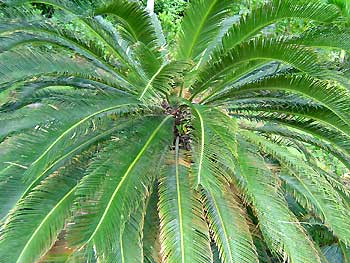
|
|
| |
Photographed: At
the Hotel Regis in Panajachel at Lake Atitlan in Guatemala,
in 2011.
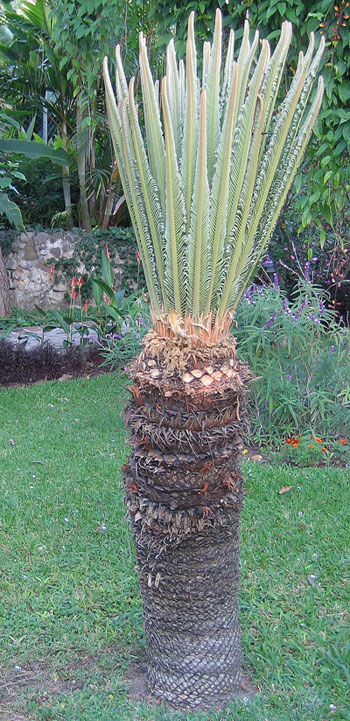
|
Photographed: At
the Hotel Regis in Panajachel at Lake Atitlan in Guatemala,
in 2011.
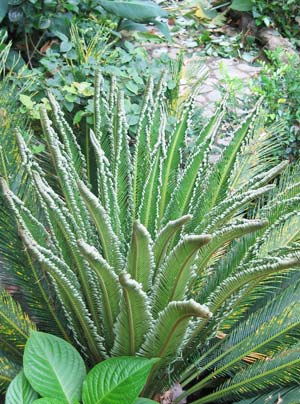
|
|
| |
Photographed: At
the Hotel Regis in Panajachel at Lake Atitlan in Guatemala, in
2011.
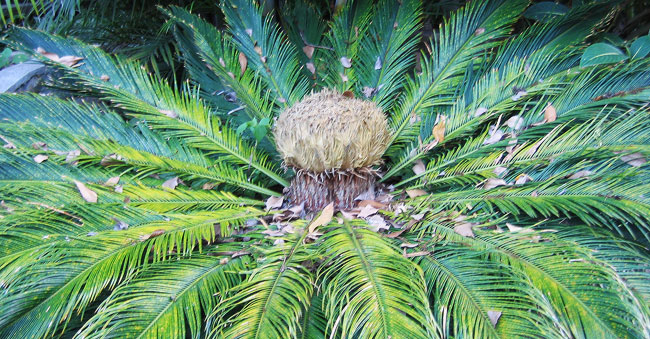
|
| |
Photographed: This
photographs of a sago in bloom was taken in the city gardens
in Malaga, Spain, in 2012.
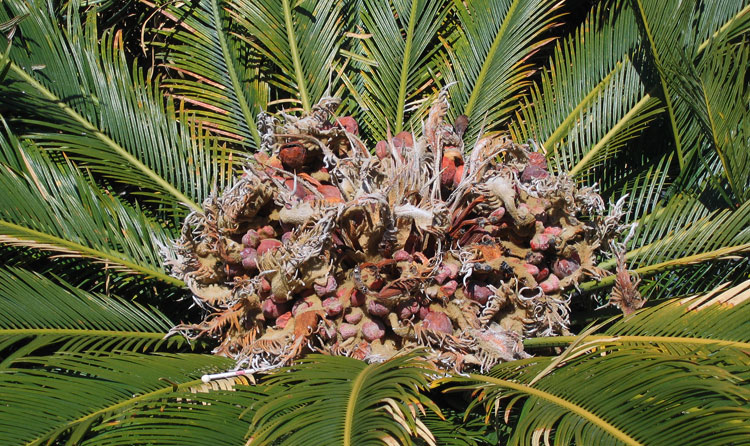
|
| |
|
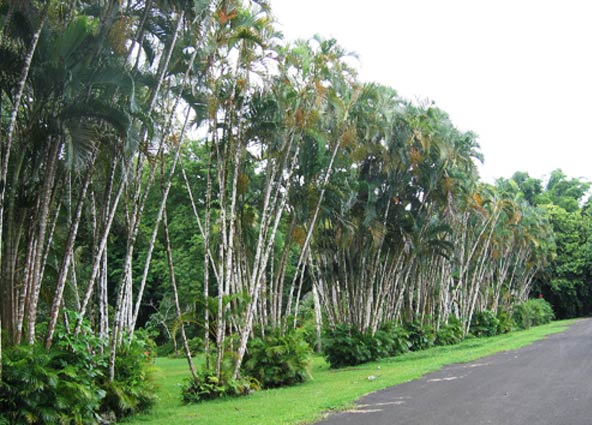
 **Dwarf
Coconut Palm Tree
**Dwarf
Coconut Palm Tree
 **Jamaica
Sago, Cardboard Palm, Scurfy Zamia, Cycad Zamia
furfuracea
**Jamaica
Sago, Cardboard Palm, Scurfy Zamia, Cycad Zamia
furfuracea
